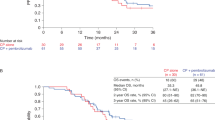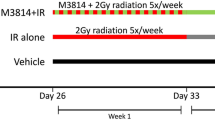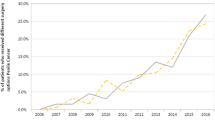Abstract
A Phase I study of oral daily misonidazole (MISO) with conventional pelvic irradiation, has been conducted in patients with carcinoma of the cervix Stages IB, IIB, IIIB and IVA. MISO was administered in daily dosages to sequential groups of patients at doses of 0.15 g/m2, 0.30 g/m2 or 0.45 g/m2 for 22 days over 5 weeks. Sixteen patients were assigned to each dose level. Using a double-blind randomization, they received either placebo (3/16) or MISO (13/16). The major dose-limiting toxicity was peripheral neuropathy (PN). None of the 13 patients receiving 0.15 g/m2 or the 13 receiving 0.3 g/m2 developed PN. However, 6/13 at the 0.45 g/m2 level (total dose less than or equal to 9.9 g/m2) developed PN. Additional patients were entered at this level and a total of 13/26 developed PN, which was considered of clinically significant severity in 9. Symptoms of PN have persisted from 1 week to 10 months, and have been completely reversed in 9/13 patients. Pharmacological parameters were examined for correlation with clinically evident toxicities. Although peak plasma MISO levels and half-lives did not correlate significantly with PN, there was a significant correlation between the calculated "area under the curve" (AUC) and PN. No correlation exists between PN and total urinary excretion of MISO or the O-demethylation product. A daily dose of 0.45 g/m2; MISO (total dose less than or equal to 9.9 g/m2) is considered to produce an acceptable level of toxicity for this patient population.
This is a preview of subscription content, access via your institution
Access options
Subscribe to this journal
Receive 24 print issues and online access
$259.00 per year
only $10.79 per issue
Buy this article
- Purchase on SpringerLink
- Instant access to full article PDF
Prices may be subject to local taxes which are calculated during checkout
Similar content being viewed by others
Rights and permissions
About this article
Cite this article
Thomas, G., Rauth, A., Black, B. et al. A phase I study of misonidazole and pelvic irradiation in patients with carcinoma of cervix. Br J Cancer 45, 860–868 (1982). https://doi.org/10.1038/bjc.1982.138
Issue date:
DOI: https://doi.org/10.1038/bjc.1982.138



